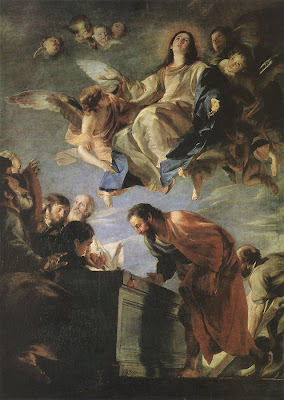A Commentary on the Mass of the Assumption of the Blessed Virgin Mary
There is no better way to enter into the mystery of any feast than by passing through the portals opened for us by the Church herself in the texts and signs she has chosen for it. Nothing of what the Church says and does in the liturgy is without significance. Every word, every gesture, is, as Psalm 118 puts it, "a door opening onto the light, giving intelligence to the simple" (Ps 118:130).
Introit
Gaudeamus! The Mass today opens on a note of irrepressible joy: Let us all rejoice in the Lord, celebrating a festival in honour of the Blessed Virgin Mary, at whose Assumption the angels rejoice and all together praise the Son of God. This is no mere earthly joy; it is the joy of heaven spilling over, cascading down through the choirs of angels until, having reached us here below, it again takes flight heavenward, leaving us surprised by joy.
The joy of today's festival descends from heaven and returns to heaven. It leaves us caught up in a mystery bigger than ourselves, obliges us to set our sights "on the things that are above, where Christ is, seated at the right hand of God" (Col 3:1). It is as if the Virgin Mother herself, borrowing the words of the Apostle, speaks to us out of that glory in which she is "hidden with Christ in God" (Col 3:3), and says, "Set your minds on things that are above, not on things that are on earth" (Col 3:2). The Assumption of the Mother of God is a jubilant "Sursum corda!"
Collect
Almighty and ever-living God,
by whom Mary, the immaculate Virgin Mother of your Son,
was taken up, body and soul into the glory of heaven:
grant, we beseech you,
that, ever intent on the things that are above,
we may become worthy
of sharing in the glory that is hers.
The Collect of the day flows directly out of the Introit. What the Introit proclaims in song, the Collect turns into prayer. We address the Almighty and ever-living God, the God for whom, as the Angel said to Mary, "nothing is impossible" (Lk 1:37). We confess the Church's firm belief that Mary, at the term of her mortal life, was taken up, body and soul, into the glory of heaven. An astonishing thing! That Mary should be in heaven spiritually, is something easily conceded. That her very body should be mysteriously "hid with Christ in God" (Col 3:3) is quite another thing.
The dogma of the Assumption declares that the human body, being constitutive of who we are, is not expendable, not a mere wrapping to be discarded. Our bodies have a glorious destiny: the liturgy of the heavenly Jerusalem, described in the book of Revelation, will engage our bodies as well as our spiritual souls. The Mother of God is already engaged body and soul in that heavenly liturgy where the priests of Sion "are clothed with salvation and her saints rejoice with exceeding great joy" (Ps 131:9). This is why the Preface will call Mary, "the beginning and likeness of the Church in her fullness."
The petition of the Collect asks that, "ever intent on the things that are above, we may become worthy of sharing in the glory that is hers." The language of this petition is lifted directly from Colossians 3:1: "Seek the things that are above." Everything today moves upward. Everything is caught up in that movement of return to the Father inaugurated by resurrection and ascension of Christ our high priest, a grand entrance procession wonderfully continued in the assumption of his Mother.
Prayer Over the Offerings
May the offering of ourselves
rise up into your presence, Lord;
and may the all-blessed Virgin Mary,
taken up to heaven by you,
so help us by her intercession,
that our hearts, set ablaze with the fire of love,
may ever yearn for you.
The Prayer Over the Offerings intensifies the upward movement into the presence of God, but here, the upward movement becomes one of offering. Ascendat ad te are the opening words of the prayer. The images are those of Psalm 140, the song of the evening sacrifice: "Let my prayer arise before you like incense, the raising of my hands like an evening oblation" (Ps 140:2). This is the prayer of the Virgin Mary at the hour of her passing-over. Mary herself is the incense rising at the evening hour of her earthly life. "Who is she coming up from the wilderness, like a column of smoke, perfumed with myrrh and frankincense?" (Ct 3:6). And so we pray, "May the offering of ourselves rise up into your presence, Lord, and may the all-blessed Virgin Mary, taken up into heaven by you, so help us by her intercession, that our hearts, ablaze with the fire of charity, may ever yearn for you."
The image of incense rising is coupled with that of hearts set ablaze with the fire of charity. In the ancient form of the Mass, the priest, after incensing the altar, returns the thurible to the deacon, saying, "May the Lord kindle within us the fire of his love, and the flame of undying charity." There is something of that prayer in today's Prayer Over the Offerings. It invites us to cast our lives, our very selves, like grains of incense onto the glowing embers of a charity fanned by the Spirit. Thus do we ascend heavenward with Mary's evening sacrifice as an offering made to God.
Preface
Truly it is right and just, our duty and our salvation,
always and everywhere to give you thanks,
Lord, holy Father, almighty and eternal God,
through Christ our Lord.
Today the Virgin Mother of Christ
was taken up into the heavens,
to be the beginning and likeness
of your Church in her fullness
and an assurance of hope and consolation
for your people on their pilgrim way.
You would not let her see corruption in the grave
for she had given birth to your Son, the author of all life,
in the wonder of his Incarnation.
United therefore with all the choirs of angels,
we praise you, and in gladness proclaim:
The Preface of today's Mass sees in the Virgin Mother of Christ an icon of what the whole Church will be in her fullness. From her place in heaven, Mary shines as "an assurance of hope and consolation" for us as we make our pilgrim way through this valley of tears. The Preface borrows its imagery from Chapter Eight of Lumen Gentium: "The Mother of Jesus in the glory which she possesses in body and soul in heaven is the image and beginning of the Church, as it is to be perfected in the world to come. Likewise she shines forth on earth, until the day of the Lord shall come (cf. 2 P 3:10), a sign of certain hope and comfort to the Pilgrim People of God" (LG, art. 68).
In Mary's shining forth from heaven, one detects also something of Saint Bernard's marvelous sermon on Mary, the radiant Star set by God in the heavens. Listen to the Abbot of Clairvaux: "Mary is that star I say, uplifted over the ocean of this world, shining by her merit and shedding light on us by her example. O you who struggle in this stormy sea, do not turn your eyes from this star, if you would escape shipwreck! When the winds of temptation arise and you run on the rocks of tribulation, look at that star, think of Mary, call on her by name. If you follow her, you will not go off course; if you cry to her, you will not give up hope; if you think of her, you will not go astray" (Sermon IV, Super Missus Est).
The last part of the Preface draws upon Psalm 15, the prophecy that, from the time of Saint Peter's sermon on the day of Pentecost, spoke to Christians of the resurrection of Christ. What David prophesied about Christ concerns also those who belong to Him and, in the first place, His holy Mother. The Preface sings, "You would not let her see corruption in the grave for she had given birth to your Son, the author of all life, in the wonder of his Incarnation." The Psalm -- and today we hear it from the lips of the Virgin Mother -- says, "My heart rejoices, my soul is glad; even my body shall rest in safety. For you will not leave my soul among the dead, nor let your beloved know decay. You will show me the path of life, the fullness of joy in your presence, at your right hand happiness forever" (Ps 15:9-11).
Communion Antiphon
The Communion Antiphon rightly repeats a line from the Gospel of the Mass. Mary's bold prophecy at the time of her Visitation to Elizabeth is fulfilled in the mystery of her Assumption: "All ages will call me blessed, for the Almighty has done great things for me" (Lk 1:48-49). The Eucharist is the beginning in time of our eternal blessedness. It is the "beatifying" sacrament because it makes us truly happiness with a foretaste of the bliss of the blessed in heaven. The Eucharist is first among the magnalia Dei, the great things done for us by the Almighty.
Prayer After Communion
Grant, we entreat you, Lord,
to us who have partaken of this healing sacrament,
that the merits and intercession of the Blessed Virgin Mary
whom you have taken up to heaven
may bring us in our turn
to the glory of the resurrection.
The Prayer After Communion refers to the Eucharist as a health-bringing sacrament. Our Eucharistic healing will be complete only when we, like Mary, are taken up to heaven in the glory of the resurrection. One hears beneath the Prayer After Communion the words of Jesus in the discourse on the Bread of Life: 'He who eats my flesh and drinks my blood has eternal life, and I will raise him up at the last day" (Jn 6:54). The last phrase of the prayer is ad resurrectionis gloriam perducamur, "that we may be brought to the glory of the resurrection." Thus does the Prayer After Communion resume and complete the whole upward movement of today's Mass.
Ours it is to allow the prayer of the Church, her lex orandi, to penetrate us so completely that it is, not only what we believe objectively, her lex credendi, but also how we live today, tomorrow, and the next day, our lex vivendi. Evelyn Underhill, at the beginning of her marvelous little book on the Mass, expresses it in a piece of poetry:
We rise, but but by the symbol charioted,
Through loved things rising up to Love's own ways:
By these the soul unto the vast has wings
And sets the seal celestial on all mortal things.

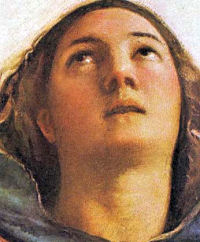
 15th
15th 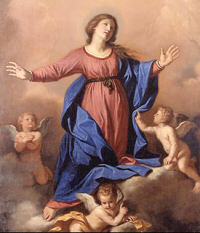 Now toward the end of the summer season, at a time when fruits are ripe in the gardens and fields, the Church celebrates the most glorious "harvest festival" in the Communion of Saints. Mary, the supremely blessed one among women, Mary, the most precious fruit which has ripened in the fields of God's kingdom, is today taken into the granary of heaven.
Now toward the end of the summer season, at a time when fruits are ripe in the gardens and fields, the Church celebrates the most glorious "harvest festival" in the Communion of Saints. Mary, the supremely blessed one among women, Mary, the most precious fruit which has ripened in the fields of God's kingdom, is today taken into the granary of heaven. 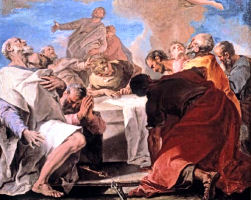 At the Council of Chalcedon in 451, when bishops from throughout the Mediterranean world gathered in Constantinople, Emperor Marcian asked the Patriarch of Jerusalem to bring the relics of Mary to Constantinople to be enshrined in the capitol. The patriarch explained to the emperor that there were no relics of Mary in Jerusalem, that "Mary had died in the presence of the apostles; but her tomb, when opened later . . . was found empty and so the apostles concluded that the body was taken up into heaven."
At the Council of Chalcedon in 451, when bishops from throughout the Mediterranean world gathered in Constantinople, Emperor Marcian asked the Patriarch of Jerusalem to bring the relics of Mary to Constantinople to be enshrined in the capitol. The patriarch explained to the emperor that there were no relics of Mary in Jerusalem, that "Mary had died in the presence of the apostles; but her tomb, when opened later . . . was found empty and so the apostles concluded that the body was taken up into heaven." 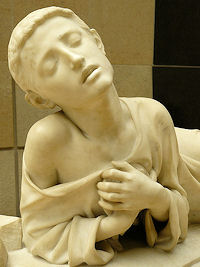 Tarcisius was a twelve-year-old acolyte during one of the fierce Roman persecutions of the third century, probably during that of Valerian. Each day, from a secret meeting place in the catacombs where Christians gathered for Mass, a deacon would be sent to the prisons to carry the Eucharist to those Christians condemned to die. At one point, there was no deacon to send and so St. Tarcisius, an acolyte, was sent carrying the "Holy Mysteries" to those in prison.
Tarcisius was a twelve-year-old acolyte during one of the fierce Roman persecutions of the third century, probably during that of Valerian. Each day, from a secret meeting place in the catacombs where Christians gathered for Mass, a deacon would be sent to the prisons to carry the Eucharist to those Christians condemned to die. At one point, there was no deacon to send and so St. Tarcisius, an acolyte, was sent carrying the "Holy Mysteries" to those in prison. 


